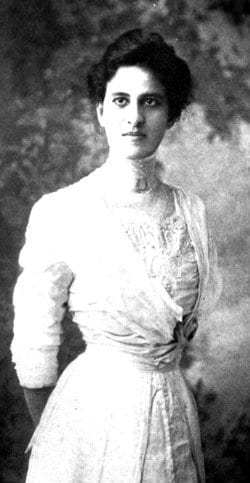

While enduring more than her share of personal misfortunes, Maud Cuney-Hare showed a love of music and the theatrical arts, and an untiring dedication to uplifting her race. She was born in Galveston, Texas on Feb. 16, 1874, the daughter of Adelina Dowdie Cuney, a schoolteacher, and famed politician Norris Wright Cuney. As members of a relatively well-to-do family, she and her brother, Lloyd Garrison, enjoyed privileged childhoods.
Her father served as an alderman in Galveston and helped unionize black dockworkers. He later became chairman of the Texas Republican Party. In 1889, President Benjamin Harrison appointed him U.S. collector of customs for the port of Galveston.
Although one of eight children born to a bondswoman of mixed race and one of the largest slaveholders in Texas, Norris Wright Cuney identified with black people’s plight. He instilled in his daughter a strong sense of racial pride and a loathing for all forms of racism. Maud Cuney was raised in a musical household. Her mother, a former slave, possessed a “beautiful, dramatic soprano voice” and played piano. Her father played violin. Both parents stressed to their children the value of reading and education.
After graduating from Central High School in Galveston in 1890, Maud Cuney moved to Boston at the age of 16 to study music, German and English literature at the New England Conservatory of Music. After she and Florida L. Des Verney, another woman of mixed race, enrolled as boarding students on Sept. 11, 1890, they created a considerable stir. Although some white students established friendly relations with the two young ladies, other students — Southern segregationists — complained of their presence and demanded their expulsion. That both women had been excellent students did not matter to their racist foes.
On the boarding controversy, the New England Conservatory offered the women no support. Richard A. Dana, vice president of the conservatory, announced that its executive committee had come “to the conclusion that while it was their duty to keep open all the educational facilities of the institution to all classes, they could not enforce social regulations.”
“In this dilemma, without closing the door of the institution, the committee thought it best to lay the case before the parents of the colored young ladies,” Dana said, “suggesting that it would be more conducive to their happiness if they should board outside.” He expressed “deep regret on the part of the committee that they had failed in their undertaking in making the home socially agreeable to all.”
The Colored National League (CNL) responded on the night of Nov. 4, 1890 by holding a packed meeting of concerned citizens in the vestry of the Charles Street A.M.E. Church. They vented indignation at the way the conservatory had treated the two women. CNL President Edwin Garrison Walker presiding, the league adopted a resolution calling attention to the fact that objection to the students based on their race was prohibited by Massachusetts law, and further calling upon the school’s management “to see that justice was done to all, irrespective of color.” It appointed a committee comprised of attorney Edward Everett Brown, John J. Smith and others to deliver the resolution to the school.
The CNL was not alone in supporting Cuney. Then-Harvard student W.E.B. Du Bois, to whom she was at one time engaged, decades later wrote, “When the New England Conservatory . of Music tried to ‘jim crow’ her in the dormitory, we students rushed to her defense and we won.”
Cuney defended herself, contending, “I cannot help it if I am colored. I have violated no rule. My conduct has never been met with reproof. My studies have been satisfactory; with few exceptions I believe the majority of students are with us, and I get along exceedingly well. I have done nothing that the few can take exceptions to.” She concluded, “As for my color, I am satisfied with it. I expect a letter shortly from my father, and I know that he will tell me to stay, and stay I shall.”
In the wake of the school’s subsequent silence on the matter, she stayed, graduating in 1895 to become a masterful concert pianist and music instructor. She was subjected to many petty indignities while there, but insisted upon proper treatment.
As a student, she volunteered to help charitable organizations. In aid of St. Monica’s Home for Sick Colored Women and Children on Joy Street, she and other young ladies of color gave “a strawberry high tea” on June 22, 1892. The Sisters of St. Margaret established St. Monica’s Home in 1888 to accept patients with incurable cases who could not be admitted to the general hospitals and to feed those in need of proper nourishment. Cuney would later become an active participant in the League of Women for Community Service at 558 Massachusetts Ave., founded by Josephine St. Pierre Ruffin in 1918.
Along with music, Cuney also loved literary and theatrical arts. After completing her studies at the New England Conservatory of Music, she enrolled in the Lowell Institute at Harvard University, where she continued to study English literature.
She then returned to Texas and, in 1897, served as director of music at the Texas Deaf, Dumb, and Blind Institute for Colored Youths, outside Austin. In 1899, she taught piano at the settlement program of a black church in Chicago. From 1898 to 1902, she married and divorced J. Frank McKinley, a biracial doctor 20 years her senior. They met and married in Austin, and he convinced her to move to Chicago, where he insisted that they disavow their African heritage and “pass” as “Spanish Americans.” Since her father had taught her to be proud of her black heritage, Cuney found her marriage wanting. The couple had one child, Vera, before parting in 1902.
After two years as a music instructor at Prairie View State College in Texas, she returned to Boston. She did not stay single long; on August 10, 1904, married William Parker Hare, a black Bostonian. They settled down at 43 Sheridan St. in Jamaica Plain.
Cuney-Hare resumed teaching piano at her home. She met Boston’s black intellectuals and social elite and served on the executive committee of the St. Mark Musical and Literary Union. As a longtime friend and confidant of W.E.B. Du Bois, she often wrote him letters, affectionately referring to him as “My Dear Du,” and in 1907, she became one of the first women to join the Niagara Movement — a civil rights organization that he co-founded.
For more than 20 years, Cuney-Hare accompanied the renowned baritone William Howard Richardson on concert tours. They gave a free concert at Ford Hall on Beacon Hill on Nov. 19, 1916, performing musical compositions by baritone Henry “Harry” Thacker Burleigh, a distinguished African American music scholar and composer, and George Frideric Handel. She also performed a piano selection by Arturo Buzzi-Peccia titled “Gloria.”
Cuney-Hare endeavored to lift the race through cultural enrichment. Assisted by Richardson, she delivered a lecture in Boston in 1916 on “The Contribution of the Afro-American to the Art of Music.” About her work a Boston Transcript critic wrote, “Her charming personality, her simple manner of speaking, combined with her artistic performance in both solo work and as an accompanist won the admiration of the audience.”
At Boston’s Old South Meetinghouse, she and Richardson teamed up with African American tenor soloist Roland W. Hayes. They offered a musical program on Jan. 14, 1917 that included piano selections by her, baritone solos by Richardson and tenor solos by Hayes, who would later become widely acclaimed.
On the evening of Feb. 19, 1920, Cuney-Hare and Richardson presented a “music-talk” and recital of African American and Creole folk music at Steinert Hall in Boston. She brought further public attention to Creole music by publishing a book in 1921 titled Six Creole Folk Songs. As a music historian and folklorist, she travelled extensively, visiting Mexico, Haiti, Cuba, Puerto Rico and the Virgin Islands, collecting folk songs and dances, and documenting their African origins.
In 1927, she founded the Allied Arts Centre at 295 Huntington Avenue, a nonprofit community-based organization created to discover and encourage musical, literary and dramatic talent and arouse interest in the artistic capabilities of African American youth. Under her direction, the center held lectures, concerts and classes in music, dance, voice and drama, and embraced a children’s “little theatre” in Boston’s black community. While the center raised no great sum of money, it maintained a workshop, enabling the unknown writer to learn his technique.
Cuney-Hare contributed articles to periodicals such as Musical America, Musical Observer, Musical Quarterly and the Christian Science Monitor and for years served as music editor of The Crisis — the journal of the NAACP. In 1913, she published a biography of her father, Norris Wright Cuney: A Tribune of the Black People, and edited a collection of poetry titled The Message of the Trees: An Anthology of Leaves and Branches (1918). A gifted playwright, she also wrote Antar of Araby, a play about a black Arabian slave poet-warrior, and on May 15, 1928, staged it in Boston under her direction with the Allied Arts Players.
In 1908, Cuney-Hare’s daughter died at the age of 8. If that personal tragedy was not enough to crush her spirit, tuberculosis claimed both her parents and left her brother, Lloyd, incapacitated. Learning in December 1930 of advanced tuberculosis in her brother’s lungs, she wrote, “I have girded on my armor now and I am prepared to make the fight with him, hopeless as it may seem.”
Her live-in mother-in-law and her second husband, William, also suffered ill health, requiring Cuney-Hare to become a “nurse, maid and housekeeper in one.” Vowing to stick by her husband, she informed Du Bois in a letter on July 17, 1932, “I want to stay in Boston or nearby if possible, as I cannot leave Will, an invalid. He has no one but me.” Indeed, she showed great concern for others, though by then she herself had been diagnosed with cancer.
As a participant in the Harlem Renaissance, she helped to document the development of black America’s musical and theatrical arts movement. But Cuney-Hare is best known for her groundbreaking book, Negro Musicians and Their Music. Published in 1936, the 439-page volume traces the development of African American music from its African roots to the birth of jazz.
Shortly before the publication of that work, Maud Cuney-Hare died of cancer in Boston on Feb. 13, 1936. That this multi-talented charitable woman was able to accomplish what she did while caring for ill family members and fighting her own battle with cancer is astonishing. Du Bois called her “the bravest woman” he had ever known.






